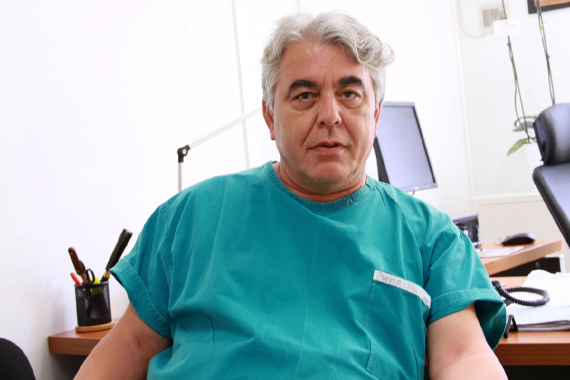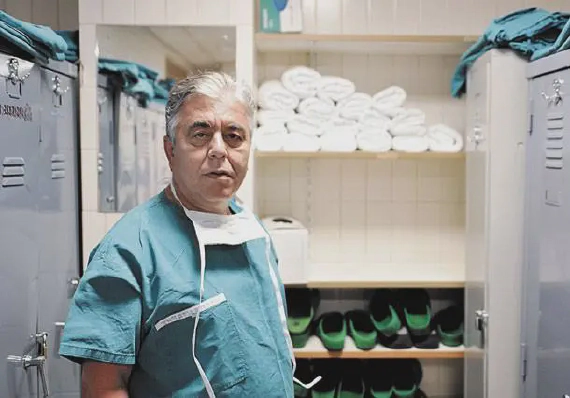
Greece, your bureaucracy: After 10,000 operations they wanted proof that he was a heart surgeon (Translation)
In Germany Andreas Bairaktaris was the head of a team of 90 scientists - In Greece he was subjected to specialty …

Cardiologist Andreas Bairaktaris, Doctor of Medicine at the University of Bochum, is currently Director of Cardiothoracic Surgery at IASO General. We asked him to inform us about the occurrence of cardiovascular diseases in women and we found him assuring us that:
“After many years in cardiac surgery and with the experience I have gained, what I have found is that there are no female or male hearts. All hearts are equally sensitive and all need our utmost attention and care.”
Cardiovascular diseases are the leading cause of death in developed and developing countries, so our country is no exception. Although heredity plays a key role in the occurrence of heart disease, our changing lifestyles over the last 25-30 years have contributed to an increase in the incidence and consequences of cardiovascular disease for both sexes.
Also, in the last 15-20 years, due to an increase in the average age of men (75 years) and women (80 years), there has been an increase in the attendance of elderly patients for the treatment of cardiovascular diseases, such as diseases of the heart, thoracic and abdominal aorta and peripheral vessels.
Regarding the clinical picture, the latest data indicate that women are less likely to visit emergency rooms because they believe that they do not have a serious heart problem and this is because the symptoms of cardiovascular diseases (especially heart disease) in women are atypical, such as nausea, weakness, shortness of breath and they rarely report the characteristic tightening pain in the chest.
Women more often present with risk factors for coronary artery disease, such as diabetes mellitus and peripheral vascular disease. The rate of death from stroke in women is 60% of all stroke deaths. From the above mentioned we can conclude that the clinical picture of heart diseases in women is most often has an atypical and insidious form.
The diagnosis of heart diseases does not differ in both sexes and the methodology is the same. The diagnosis of any acquired heart disease in both sexes consists of three stages:
(a) the clinical examination which includes taking a proper medical history that can provide useful information about the present disease and also about the individual and hereditary history, palpation and stethoscope listening,
b) blood tests such as complete blood count, biochemistry, lipid profile of the patient, but also other specialized tests necessary for a correct diagnosis, and finally
c) the paraclinical examination consisting of simple tests such as electrocardiogram or cardiac ultrasound up to invasive diagnostic coronary angiography. As far as the newer diagnostic methods are concerned, these are CT and MRI of the heart, CT coronary angiography and 3D CT angiography.
At this point we should note, that the clinician should be suspicious during diagnostic and differential thinking whether a woman is suffering from a heart disease or not since the symptoms in women often have an atypical form.
The treatment options and treatment strategies available for heart disease do not differ between men and women. Where there is a difference is in the frequency of procedures performed, depending on the incidence of heart disease in both sexes. For example, coronary artery bypass grafting is more common in men than in women. As shown and known, 25% of coronary bypasses and 33% of angioplasties for coronary artery disease were performed in women.
In terms of cardiac surgery in women as a whole (data from Europe) the percentage has risen from 26% to 30% from 1999 to 2009. It has been observed that women have a higher mortality (3%) after bypass than men (1.9%), but the long-term outcomes are the same in both sexes.
Regarding heart valve disease, we know that heart valve surgery is performed 50-55% in women (mainly mitral and aortic valve stenosis) and this is probably due to the fact that women are smaller than men and thus the valve is smaller in size and as a result the hemodynamic disturbances caused by stenosis are more severe and cause symptoms relatively quickly, as far as valve disease is concerned. Mortality after aortic valve replacement does not differ between the sexes and is 2.8-3.0%, while in complex procedures involving coronary artery bypass grafting there is a difference in women is 7.5% and in men 4.6%.
Apparently, coronary artery disease plays an important role. Mortality after mitral valve replacement does not differ between genders even if coronary artery disease is involved. In 2011, heart transplants (due to advanced heart failure) performed in 2011 involved women at a rate of 31%. Regarding the treatment of heart disease in women, what we should note and remember is that women may be a separate group of patients undergoing cardiac surgery, but the ways and methods of treatment are the same in both genders and in both men and women.
In this short article we have tried to present a few facts about a huge topic, such as heart diseases affecting the female population and the ways of treating them. Although there is some specificity in the epidemiology, clinical picture and treatment of heart diseases in women, the ultimate goal regardless of gender is to offer an optimal outcome after treatment, which is to improve the patient’s life and increase her life expectancy. And how do we achieve this: by approaching the cardiac patient as a fully functioning and self-regulating system, which contributes to finding the most appropriate and effective treatment.
The treatment options that follow should meet at least the following basic criteria:
(a) patient safety
(b) the choice of treatment must be evidence-based
(c) adequate material-technical infrastructure
(d) sufficient medical-nursing staff
(e) the ability to predict the desired or undesirable outcome before, during and after the application of the treatment
(f) monitoring of the outcome of the treatment. Systematic analysis of the preoperative, perioperative and postoperative parameters of a patient undergoing cardiac surgery contributes not only to a safe outcome of the surgical treatment, but also to achieving the best possible outcome for the patient.
Women who have a burdened personal and hereditary history should be suspicious and at least have a screening regarding their heart function. As soon as a problem is found or there are some worrying signs, what you should do is to modify your lifestyle and have regular monitoring by your doctor.
The simple tips for lifestyle change are: diet modification, weight reduction, regular monitoring of blood pressure, increasing physical activity, blood sugar control (if there is a problem), immediate cessation of smoking and alcohol. Regular communication and monitoring by your doctor provides you with valid and reliable information, proper prevention and treatment of the possible problem you are facing, because the qualified doctor can guide you and help you to properly solve the problem you are facing.
Edited by Fotini Androulaki

In Germany Andreas Bairaktaris was the head of a team of 90 scientists - In Greece he was subjected to specialty …

It reminds me of that song by Dalaras that says “who saw a boat on Helmos, in Metsovo a boat”. I knew that …